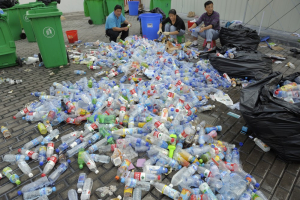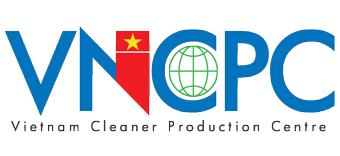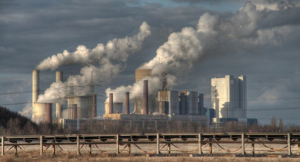How Asia can clean up its waste problem
What are the key barriers to better waste management and resource efficiency in Asia? This year’s Macao International Environmental Co-operation Forum & Exhibition shines a spotlight on ways governments and business leaders can tackle Asia’s waste challenge.

Chinese workers manually sort and recycle plastic bottles in Shanghai, China. Experts say that China has the potential to lead Asia – and possibly the world – in adopting circular economy business models, which reduce resource wastage. Image: Trial / Shutterstock.com
China is now the largest economy in the world, but this record-breaking growth has put unprecedented stress on the country’s pollution control, transport, and waste management infrastructure.
The country’s energy consumption per unit of gross domestic product (GDP) is more than twice that of the world average, and a similar pattern is seen in the consumption of other resources such as steel, cement and other raw materials, according to the World Resources Institute (WRI).
But while these growing pains are acutely felt in China, the rest of Asia’s developing countries are also all too familiar with the industrial contamination, water and land pollution, and indiscriminate waste dumping resulting from poorly managed economic development.
Asia’s waste management woes are undermining public health and safety, worsening the quality of life for citizens, and reducing the land available for cities to expand, say experts, adding that failure to address them could slow economic growth and undermine people’s well-being.
This is why the Macao International Environmental Co-Operation Forum & Exhibition 2016 (2016MIECF) – an annual sustainability mega-event – is focusing on the policy and technical solutions needed for better waste management in Asia, and the economic benefits of adopting these measures.
“The quantity of solid waste has been increasing rapidly in China and other developing countries in the region,” says the 2016MIECF organiser. “Waste Management is a critical issue that affects various aspects of society, the economy, and the environment.”
Macao is perhaps better known as a tourism destination, but its strategic location in the Pearl River Delta – a key growth hub in China and one of the world’s most densely populated regions – also presents an opportunity for the Chinese special administrative territory to emerge as a sustainability leader in China and the rest of Asia.
The three-day event, organised by the Macao government and themed Green Economy – Opportunities for Waste Management, aims to bring together top business and government officials from the region for a series of conference sessions, networking opportunities, and exhibitions to highlight new tools and ideas for better waste management.
Reducing waste, increasing profits
Torben Kristiansen, vice-president of waste and contaminated sites at Danish consultancy COWI, who will be speaking at the event, says that the root cause of Asia’s waste problems is the poor organisation of government policies and national waste management infrastructure.
In Kristiansen’s home country of Denmark, less than four per cent of all waste is sent to the landfill. Everything else is recycled or incinerated for energy. This is also the case across other Northern European countries including Sweden, Austria, Belgium, and The Netherlands.
This so-called “multi-stream” waste infrastructure is the result of careful policy planning, bold decisions to charge waste management fees to fund infrastructure and the means to enforce things like fee collection or recycling laws.
“Without this structure in place, even fancy, expensive technologies will fail or prove a lot less efficient than planned,” says Kristiansen.
There are two key misconceptions that hamper the development of a sustainable and multi-streamed waste management system in Asia’s emerging economies, says Kristiansen.
“First, the belief that technology is the answer to waste problems; and second, an unwillingness to pay for an advanced waste management system,” he notes.
To effectively manage Asia’s growing amounts of municipal and industrial waste, “countries should focus on perfecting organisational details like logistics, regulations, financial mechanisms such as investments and taxes, and enforcement measures,” says Kristiansen.
“Countries should focus on perfecting organisational details like logistics, regulations, financial mechanisms such as investments and taxes, and enforcement measures.” According to Torben Kristiansen, vice president of waste and contaminated sites, COWI
In addition to government efforts, the private sector also has a role to play in achieving zero-waste in Asia. One emerging business model with huge potential in the waste industry is the circular economy, says Swiss Professor Walter Stahel, widely regarded as one of the founding fathers of the field.
The circular economy system aims to be regenerative – that is, it keeps resources in use for as long as possible by finding ways to recover them at the end of a product’s life cycle, after which it gets reused, recycled or remanufactured.
The economic benefits of the circular economy go far beyond its ability to help save on buying virgin natural resources, says Stahel, who will deliver the keynote speech at 2016MIECF.
The circular economy can create new jobs without needing to rely on the extraction of natural resources, and also increase a country’s economic competitiveness, he says.
But although Asia has traditionally been a hub for reusing and repairing goods – with informal services such as garment repair and tyre restoration common throughout the region – the formal circular economy has been slow to take off, notes Stahel.
This is because firstly, the circular economy is not a political priority among the region’s policymakers, and second, companies have little incentive to innovate more resource-efficient business models because a growing middle class means that there is no shortage of demand for their wares – and hence, there is no impetus to innovate new, circular ideas.
But if businesses and governments commit to integrating circular economy concepts into their working models, “quantum leaps in competitiveness are possible,” says Stahel, who is the brain behind key industry concepts like ‘cradle to cradle’ and ‘performance economy’.
In cradle to cradle, or C2C manufacturing, goods are made, dismantled and re-made into new products while in the performance economy, also known as the “goods as services” system, companies sell the utility offered by an object to customers, not the item itself.
For example, tyre manufacturer Michelin sells mileage to customers, not tyres. When a tyre is no longer roadworthy, it replaces them for clients, and restores the tyres in its own workshops.
Leading Asia towards zero waste
China especially should not ignore the economic potential of these resource-efficient and cost-effective ideas, a recent report by the Ellen MacArthur Foundation and Hong Kong think tank Fung Global Institute suggests.
According to the report, China has the potential to “lead the adoption of circular economies in Asia, and possibly globally”.
The circular economy’s boost to competitiveness – and China’s pole position to achieve a circular industrial system – is likely to be welcome news for the country, which ranks 28th on the World Economic Forum’s Global Competitiveness Index 2015-2016 despite being the world’s biggest economy.
Kristiansen and Stahel, along with other international speakers, will be sharing their technical and policy expertise on waste issues at the upcoming 2016MIECF, which will be held from 31 March to 2 April at the Venetian Macao-Resort-Hotel.
Macao’s government, driven by a strategic aim to nurture green business practices and knowledge-sharing among the companies operating in the region, has organised MIECF every year since 2008. Last year’s event attracted over 7,200 participants from 59 countries and regions.
2016MIECF’s conference segment will feature experts from 11 countries speaking on issues ranging from manufacturing strategies to green hospitality; and more than 400 exhibitors from 19 countries will showcase the latest environmental products and services at the 2016MIECF trade show and exhibition.
Conference participants will also have access to a slew of networking and business matching activities across the three days of the event. These include the Green Building Industry Networking session and the Pan-Pearl River Delta Environmental Technology Exchange, among others.
The conference is a timely opportunity for Asia’s leaders to act on the urgent need to step up waste management efforts, says the 2016MIECF organizer.
Source: eco-business.com

